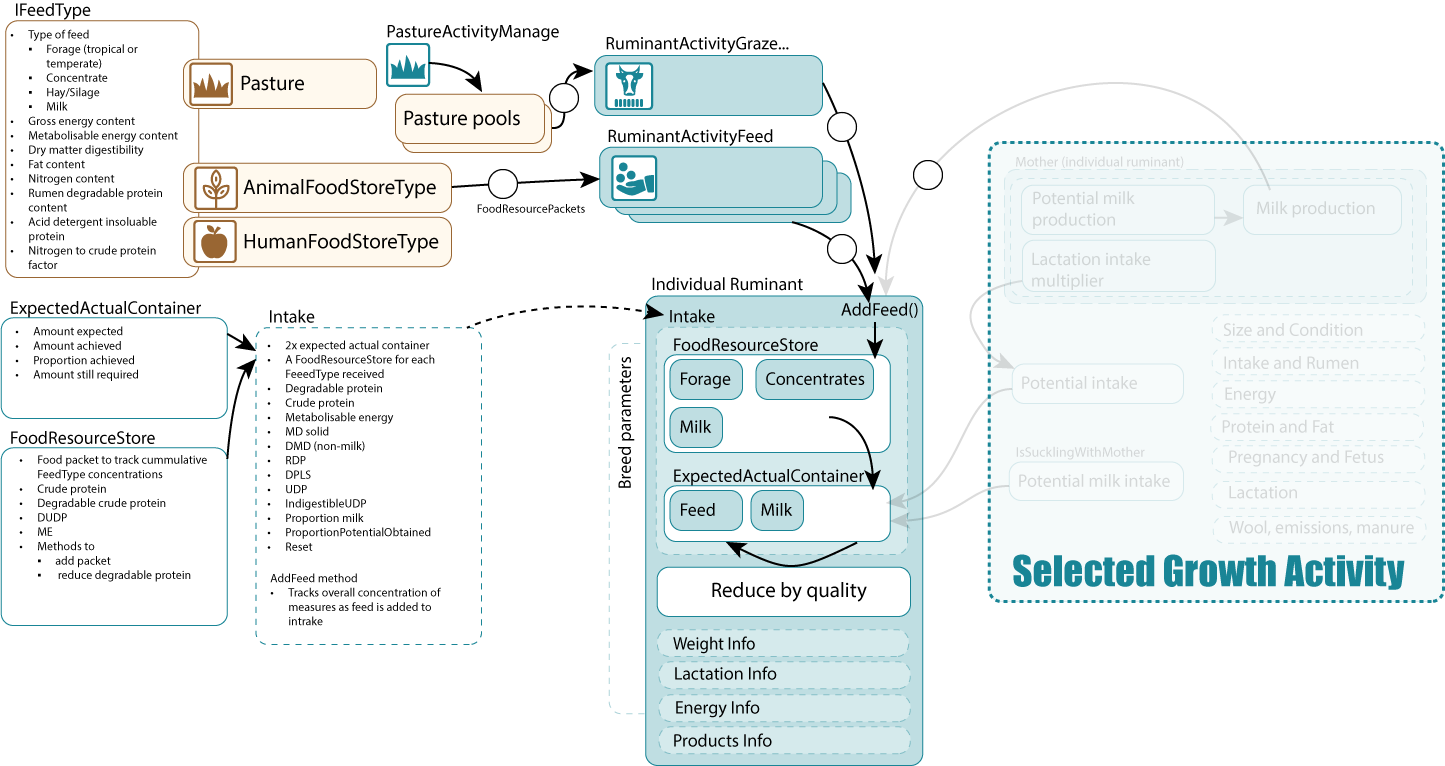Ruminant growth activities
The growth of individual ruminants is performed by one of the ruminant grow activities. These activities are responsible for determining potential intake, calculating energy allocation through maintenance, pregnancy and lactation, and determining and applying the growth possible in the time-step. These activities use the other functionality provided by CLEM to ensure the animals are fed and/or grazed and the quality of the feed consumed is tracked. These activities provide the most detailed sub-model of the CLEM system to simulate ruminant physiology. The Ruminant Parameters section was redesigned to move breed-specific parameters from the Ruminant Type component into separate, nested components allowing greater flexibility in providing only the parameters needed for the growth activity selected. While CLEM was originally provided with Grow ruminants three additional growth models (Grow ruminants (Protein and Fat), Grow ruminants (SCA'07) and Grow ruminants (Oddy)) were adding in the Major upgrade 2025 with plans to include further approaches currently being developed by CSIRO. The ruminant growth model to be used can be selected by the user based on the requirements and details required of the farm simulation. As expected the more detailed approaches require additional parameters, with fully parameterised versions of common breeds available in the examples.
A single instance of a ruminant grow activity is required anywhere in the Activities holder to implement ruminant growth. It will apply to all ruminant types in the simulation.
The following diagram shows some of the CLEM infrastructure provided and how a Ruminant Growth Activity is added.

The following ruminant growth components are available.
The Grow ruminants activity is that originally provided with CLEM. It is based on the approach used in the precursor IAT model and modified for NABSA to represent Australian beef system modelling. It is largely based on the Standing Committee for Agriculture (SCA, 2007) feeding standards equations for ruminant energy and growth and research undertaken in the 1990-2000's. It includes pregnancy and lactation demands, while having all offspring born at a standard size and a simple crude protein limitation in order to simulate poor pasture quality during the late dry season in northern Australia.
The Grow ruminants (Protein and Fat) activity is the latest implementation of ruminant energy and growth based on Australian research. It is based on the AusFarm (GRAZPlan and GrassGro models) equations (Freer et al, 2012) which were built upon the previous SCA (2007) equations. This activity was developed by James Dougherty (in prep 2024) and uses the latest animal physiology research and the equations of Freer et al (2012) to provide an updated approach to define growth in terms of empty body gain from protein and fat relating to net energy after accounting for maintenance, pregnancy, lactation and wool. This growth component was developed to align with the principles of CLEM in that it tries not to over complicate this functionality and work across the time-step interval up to monthly.
This new model provides a range of new features and functionality requested by users investigating animal condition over time while grazing the rangelands of Australia.
Like Grow ruminants, the Grow ruminants (SCA'07) activity is a representation of the SCA (2007) but simplified to only represent growing individuals typical of a feed lot. It does not include pregnancy and lactation and uses the AusFarm (Herman 2024) equations to calculate the potential dry matter intake. This simplified version was used in the testing and validation of Grow ruminants (Protein and Fat).
The Grow ruminants (Oddy) activity implements the equation and functionality of Oddy et al. which simulates ruminant growth from an energy and protein perspective tracking muscle protein, visceral protein and fat in growing animals.
See also